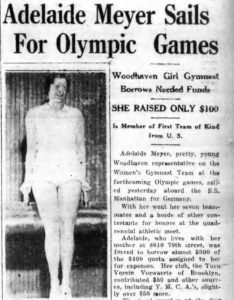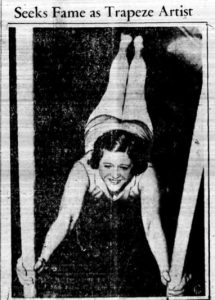By Ed Wendell
This past weekend, we all cheered as Simone Biles and the U.S. women’s gymnastics team captured the gold medal in the team finals, showcasing the extraordinary talent and dedication that gymnastics demands. Yet, as we celebrate the great achievements of these athletes, it’s worth remembering a pioneering figure from the sport’s early days: Woodhaven’s Adelaide Meyer.
Adelaide Meyer was born in 1907 and lived with her family on 79th Street near 86th Avenue. Meyer’s journey from local enthusiast to Olympic competitor began in her childhood, and it was her involvement with the Eastern District Turnverein that set her on the path to greatness.
The Turnvereins were pivotal social and political centers for immigrants, promoting physical fitness through rigorous gymnastic programs.
According to the website Brooklyn Brownstoner, “In 1811, German gymnasium instructor Friedrich Ludwig Jahn, disgusted with his country’s losses to Napoleon, came to the conclusion that part of the loss was due to the lack of physical conditioning of the average German soldier.”
“He came up with an elaborate regimen of strength training through gymnastics, naming his program and fitness philosophy turn verein, (pronounced tooorn fe-rahn) from the German verb turen meaning to perform gymnastic exercises, and verein, the word for club or organization.”
As a member of the Eastern District Turnverein, Meyer quickly distinguished herself in gymnastics. By 1929, she had earned the title of “Champion Lady Gymnast” multiple times, and her reputation continued to grow.
By 1935, Meyer was recognized by many as the top gymnast in the nation, and her fame was spreading beyond the gymnastics community. However, the excitement was tempered by a significant challenge: women’s gymnastics had not yet been included in the Olympic Games.
It was only in 1935 that the International Olympic Committee announced women’s gymnastics would be part of the 1936 Berlin Olympics. This news ignited hopes that Meyer, as a top competitor, would represent the United States.

It wasn’t until 1936 that women’s gymnastics became part of the Olympics. Unfortunately, the Amateur Athletic Union (AAU) declared that women athletes would have to pay their own way to the Games, necessitating a hasty fundraiser spearheaded by the Leader-Observer. In the end, Adelaide Meyer had to borrow funds from friends and family in order to set sail for Berlin.
Unfortunately, the Amateur Athletic Union (AAU) declared that only male athletes would have their travel expenses covered; women would have to self-fund their journey to the Games.
The news was a blow to Meyer and other aspiring female Olympians. Faced with the daunting challenge of raising funds on short notice, the Leader-Observer heralded a local campaign with the front-page headline “Let’s Send This Girl to the Olympics for Woodhaven!” seeking to gather the necessary funds.
Despite their best efforts, the fundraiser fell short. Undeterred, Meyer turned to friends and family to secure the remaining funds. In a testament to her determination and the support of her community, Meyer and the other women athletes eventually boarded the S.S. Manhattan, heading to Berlin as the United States’ very first representatives in Olympic women’s gymnastics.
Competing in events like the parallel bars, balancing beam, and horse vaulting, Meyer and her teammates delivered a commendable performance. However, the championship went to Germany and as there were no silver or bronze medals for women’s gymnastics at that time, Meyer and her teammates came home empty handed.
Nonetheless, Adelaide Meyer was celebrated for her historic achievement upon returning to Woodhaven from the Olympics. However, it was a bittersweet celebration for Meyer as she was approaching her 30s, and her career as a competitive gymnast was coming to an end.
Meyer briefly trained as a trapeze artist before stepping out of the limelight after falling in love with and marrying Joseph Treu. Her life, tragically, was cut short a few years later in 1944 when she died after a brief illness at the age of 37.

Adelaine and her teammates were celebrated for being the first US women’s gymnastic team in the Olympics. After the Games, Adelaide had a brief flirtation with the circus. However, she chose a different path, getting married and settling down instead. She died in 1944 at the age of 37.
Adelaide Meyer’s legacy endures as a symbol of pioneering spirit and resilience in women’s sports. As we reflect on the gold medal triumphs of today’s athletes, it’s crucial to remember and honor the trailblazers like Meyer who paved the way for future generations.
Her story reminds us of the dedication and courage required to reach the pinnacle of one’s sport, and her contributions to gymnastics will forever be a part of the rich history of the Olympics and Woodhaven.

